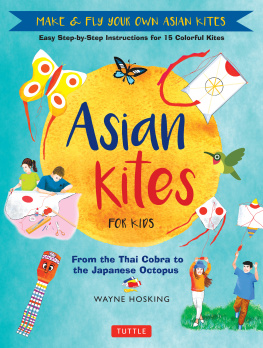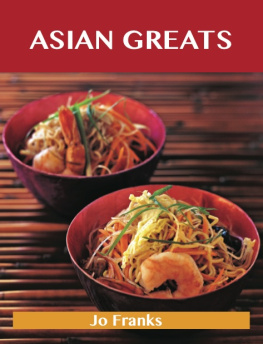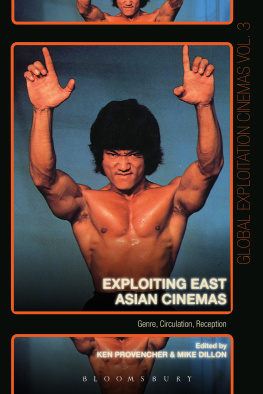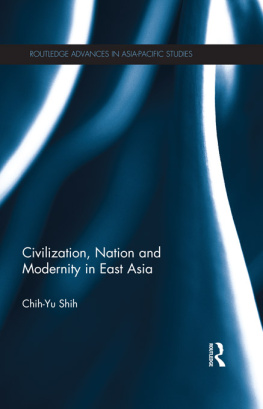Contents
Philip L. Pearce and Mao-Ying Wu
Songshan (Sam) Huang
Tingzhen Chen
Mao-Ying Wu
Huan Lu and Philip L. Pearce
Andrea Grout
Vorawan Kanlayanasukho and Philip L. Pearce
Perunjodi Naidoo and Prabha Ramseook-Munhurrun
Mao-Ying Wu and Philip L. Pearce
Aise KyoungJin Kim
Janice Scarinci and Gene Jeffers
Miha Koderman and Anton Gosar
Nevenka avlek
Karen Hughes
Amy M. Osmond
Chiemi Yagi and Philip L. Pearce
Kim Ieng Loi
Jenny H. Panchal
Philip L. Pearce and Mao-Ying Wu
Bridging Tourism Theory and Practice
Volume 7
The World Meets Asian Tourists
Bridging Tourism Theory and Practice
Series Editors:
Jafar Jafari
Istituto di Ricerca su Innovazione e Servizi per lo Sviluppo, Naples, Italy.
Tel +1 (715) 232 2339; Email <>
Liping A. Cai
Purdue Tourism and Hospitality Research Center, Purdue University, West Lafayette, Indiana 47907, USA.
Tel +1 (765) 494 8384; Email <>
Recognizing the increasing gap between what is researched in academic community and what is practiced in industry, this series aims to bring together academic and industry leaders in their respective fields to discuss, exchange, and debate issues critical to the advancement of tourism. The book series intends to not only create a platform for academics and practitioners to share theories and practices with each other, but more importantly, to serve as a collaborative venue for meaningful synthesis.
Each volume will feature a distinct theme by focusing on a current or upcoming niche or hot topic. It shows how theories and practices inform each other; how both have evolved, advanced, and been applied; and how industry best practices have benefited from, and contributed to, theoretical developments. Volume editors have both strong academic credentials and significant consulting or other industry engagement experiences. Chapter contributors will be identified through professional conferences and trade conventions. In general, the book series seeks a synergy of how concepts can inform actions, and vice versa. The book series will inspire a new generation of researchers who can translate academic discoveries to deliverable results valuable to practitioners.
Bridging Tourism Theory and Practice
Volume 7
The World Meets Asian Tourists
EDITORS
PHILIP L. PEARCE
James Cook University, Australia
MAO-YING WU
Zhejiang University, China

| United Kingdom North America Japan
India Malaysia China |
Emerald Group Publishing Limited
Howard House, Wagon Lane, Bingley BD16 1WA, UK
First edition 2017
Copyright 2017 Emerald Group Publishing Limited
Reprints and permissions service
Contact:
No part of this book may be reproduced, stored in a retrieval system, transmitted in any form or by any means electronic, mechanical, photocopying, recording or otherwise without either the prior written permission of the publisher or a licence permitting restricted copying issued in the UK by The Copyright Licensing Agency and in the USA by The Copyright Clearance Center. Any opinions expressed in the chapters are those of the authors. Whilst Emerald makes every effort to ensure the quality and accuracy of its content, Emerald makes no representation implied or otherwise, as to the chapters suitability and application and disclaims any warranties, express or implied, to their use.
British Library Cataloguing in Publication Data
A catalogue record for this book is available from the British Library
ISBN: 978-1-78560-219-1
ISSN: 2042-1443 (Series)
 |  |
Preface
A seismic shift has occurred in the 21st century. It is not so much a shift of the continental plates which organize the worlds surface, but a shift in the relationships among the people of those land masses. These relationships were previously forged by the view that the many citizens of Asian countries were hard working but relatively poor. In the countries beyond Asia, the products of this hard work were familiar with such manufacturing designations as Made in Japan, Made in Korea, and Made in China adorning many household and industrial items. In the middle of the 20th century, the notion that the citizens of these countries would become the tourists of the 21st century was barely conceivable. By the end of the millennium, it was apparent that this was an old fashioned view. The world had indeed begun to welcome Asian tourists.
Regrettably, the welcome given to the new Asian tourists was at best haphazard. The world meeting Asian tourists was not very well prepared for their arrival. Any examination of the 20th century curriculum of schools in the continents outbound Asian tourists started to visitwhether that be schools in Europe, North America, or Australiawill quickly reveal a missing agenda. Most citizens outside Asia had not learned about or studied Asian history, geography, politics, or culture. Meeting Asian tourists, both in earlier decades, and to some extent in contemporary times, was and may be enacted in a spirit of goodwill, but such welcomes are set against a background of ignorance and unfamiliarity with the customs, needs, and cultures of the visiting tourists.
The editors of this volume, one Australian Professor and one younger Chinese scholar, can relay one recent small encounter illustrating this unfamiliarity. At a conference in Australia, they acted as hosts to two Chinese colleagues who were on their first visit to a Western country. The party drove to a remote rural landscape on a very hot summers day and stopped at a small roadside caf for lunch. The Chinese guests asked for hot water to accompany their meal (the need for hot water to drink being a common Chinese practice). Somewhat confused by the request, the young teenage waiter serving at the table looked at his Australian compatriot, glanced outside at the heat charred landscape, and said conspiratorially, They want what? Isnt it damn well hot enough already! Crazy Asians! Ok I will get some.
For some time and in some different ways, the editors of this work have identified and seen a need to provide a focus in tourism research on Asian tourists traveling out of Asia. As a Chinese scholar educated in Australia, Mao-Ying Wu, has traveled to Europe, America, and around Australia and seen many Asian faces in the locations visited. She has wondered about their motivations, their experiences, and the effects of such tourist experiences on their lives. Philip Pearce has been fortunate to visit many Asian countries, and for some time he has tried to understand the problems and possibilities in cross-cultural and cross-continental encounters. These combined interests stimulated their desire to cooperate and source papers from a range of colleagues on the challenge of meeting Asian tourists. This work brings together original contributions exploring these themes. For the editors, and no doubt many of the authors of this volume, there is a lot more to do, more countries and forms of contact to be explored, but the sheer scale of out of Asia tourism suggest that the need to conduct these sorts of studies will be necessary and required in the evolution of tourism studies.
Both editors would like to thank Professor Jafar Jafari for supporting the project and being a friend as well as a diligent Series editor. Mao-Ying Wu would like to thank Australian Endeavour Award, which enabled her Australia academic trip. With the sponsorship, she made her first out-of Asia travel, which inspired more ongoing trips in and out of Asia. She is also grateful to Philip Pearce, her academic mentor, as well as his family and friends, who offered unconditional support. Philip Pearce expresses his appreciation to all the chapter authors and his internationally minded friends, near and far, who have combined to generate his ongoing interest in the meeting and mixing of people thorough tourism.













